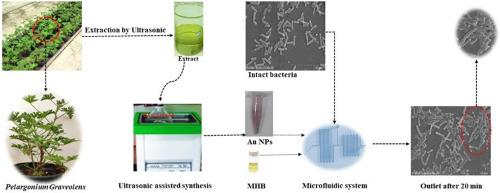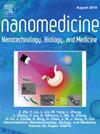Ultrasound-assisted green synthesis of gold nanoparticles using Pelargonium graveolens leaf extract: Antibacterial activity and microfluidic evaluation of mechanistic effects
IF 4.6
2区 医学
Q2 MEDICINE, RESEARCH & EXPERIMENTAL
Nanomedicine : nanotechnology, biology, and medicine
Pub Date : 2025-07-10
DOI:10.1016/j.nano.2025.102841
引用次数: 0
Abstract
Green chemistry enables sustainable, innovative, and efficient nanomaterial synthesis advancements. In this work, a green synthesis approach was employed to produce gold nanoparticles (Au NPs) using an ultrasound-assisted method with aqueous Pelargonium graveolens leaf extract. The resulting Au NPs were characterized by UV–Vis spectroscopy, X-ray diffraction, dynamic light scattering, and transmission electron microscopy, confirming cubic, stable particles with an average size of ∼41.5 nm, a zeta potential of +19.4 mV, and an absorption peak at 525 nm. Antibacterial activities of both the Au NPs and plant extract were evaluated against B. subtilis, S. aureus, E. coli, and P. aeruginosa, using conventional and microfluidic assays. Au NPs demonstrated superior efficacy (e.g., MIC for E. coli 1.56 μg/mL). Nucleic acid and protein leakage assays indicated greater membrane disruption in the microfluidic system compared to the conventional method. SEM imaging revealed substantial bacterial cell wall disruption, validating the significant antibacterial mechanisms of biosynthesized Au NPs.

超声辅助下用白天花叶提取物绿色合成金纳米颗粒:抑菌活性和微流控评价机制效果。
绿色化学使可持续、创新和高效的纳米材料合成进步成为可能。在本研究中,采用绿色合成的方法,利用超声辅助的方法,在水相天竺仙叶提取物中制备金纳米颗粒(Au NPs)。通过紫外可见光谱、x射线衍射、动态光散射和透射电子显微镜对所制得的金纳米粒子进行了表征,证实其为立方、稳定的粒子,平均尺寸为~41.5 nm, zeta电位为+19.4 mV,吸收峰位于525 nm处。采用常规和微流控实验对Au NPs和植物提取物对枯草芽孢杆菌、金黄色葡萄球菌、大肠杆菌和铜绿假单胞菌的抑菌活性进行了评价。Au NPs表现出卓越的功效(例如,对大肠杆菌的MIC为1.56 μg/mL)。核酸和蛋白质泄漏试验表明,与传统方法相比,微流体系统中的膜破坏更大。扫描电镜成像显示大量细菌细胞壁破坏,验证了生物合成金NPs的重要抗菌机制。
本文章由计算机程序翻译,如有差异,请以英文原文为准。
求助全文
约1分钟内获得全文
求助全文
来源期刊
CiteScore
11.10
自引率
0.00%
发文量
133
审稿时长
42 days
期刊介绍:
The mission of Nanomedicine: Nanotechnology, Biology, and Medicine (Nanomedicine: NBM) is to promote the emerging interdisciplinary field of nanomedicine.
Nanomedicine: NBM is an international, peer-reviewed journal presenting novel, significant, and interdisciplinary theoretical and experimental results related to nanoscience and nanotechnology in the life and health sciences. Content includes basic, translational, and clinical research addressing diagnosis, treatment, monitoring, prediction, and prevention of diseases.

 求助内容:
求助内容: 应助结果提醒方式:
应助结果提醒方式:


